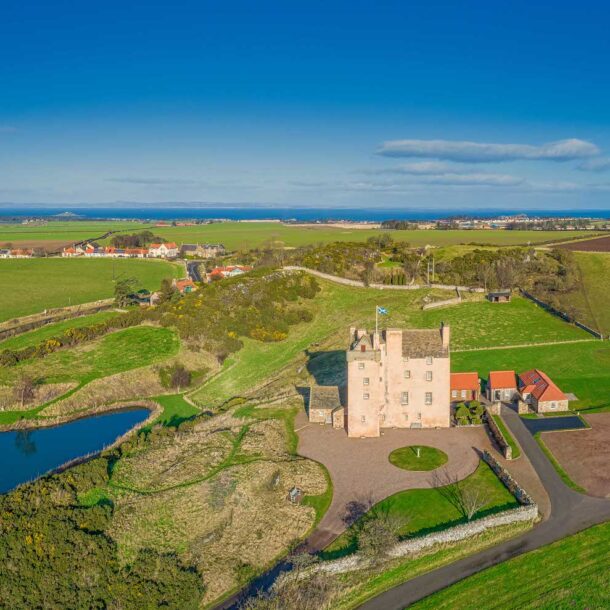

Close

Admiral Edwyn Alexander-Sinclair inherited the House of the Northern Gate from his uncle, Mr. Thomson-Sinclair. With its majestic views of the ocean and extensive coastline interspersed with inlets, bays, and sandy beaches, the estate must have appealed to the lifelong navy officer. Sinclair’s navy career spanned 1879 to 1930 and brought him across the world from China to the Baltic. In one brief but important chapter of his decades of service to the Royal Navy, he helped protect Estonia’s right to self-determination in the aftermath of World War I. Although Great Britain may have largely forgotten its critical role in the Estonian War of Independence, its naval officers are still remembered as heroes in the Baltic.
Sinclair was a “sour red-haired Scot from the wilds of Caithness, with a scrub-hammock face” who showed a willingness to go on the offensive in World War I. As the war ended, when every man in the Royal Navy was eager to go home at last, Sinclair led the only fleet that would stay in action. Sinclair’s fleet included light-cruisers and nine destroyers. His men had to grapple with the icy environs of the Baltic winter. Temperatures had already sunk far below freezing, although the water had yet to ice over. An officer below Sinclair remembered “strong, bitterly cold wind blowing from the land which was frozen and snow-covered, causing condensation over the water, and fog farther out to sea.” They had to navigate a treacherous maze of uncharted German mines. Most of the Royal Navy’s minesweepers were occupied clearing the British coastline, and the coal Sinclair needed for the one minesweeper he did have did not arrive in time to protect the fleet. Small mutinies broke out as war-weary sailors desperately tried to go home. Despite the mines and low morale, Sinclair could not wait: The Bolshevik army was approaching the Estonian capital, threatening anarchy and bloodshed. Sinclair’s fleet set out for Estonia from Denmark in early December. Just 48 hours after they left port, a massive explosion lifted one of the boats out of the water and broke its back in two places. The ship was lost, but 439 of the 450-man crew were saved.
Sinclair had no mandate beyond “[showing] the British flag and [supporting] British policy as circumstances dictate”—a vague command that did little to clarify how he should act in the tangle of conflicts unwinding in the Baltic. Estonia had a distinct language and national identity, but it had been under Russian rule for 245 of the last 300 years and hadn’t known independence since the Middle Ages. The Germans had occupied much of Latvia and Estonia during World War I, and still fought in the region because of their ambition to control part of the Baltic after the war. Estonia wanted independence, but Bolshevik Russia would have none of it. Lenin proclaimed that Bolshevik forces would “replant the Red Flag of the Proletarian Revolution” and stake out the Baltic as a Soviet sea. Strategically, control of the Baltic states was critical to the young Soviet republic: Tallinn, Estonia, and Helsinki, Finland, sit on each side of the mouth of the Gulf of Finland. The port of St. Petersburg—renamed Petrograd—lies on the eastern side of the gulf, so no boats could leave Petrograd without passing into water controlled by Helsinki and Tallinn. Meanwhile, an army of Russian White forces threatened the nascent Estonian democracy with an autocratic regime led by the old nobility, but offered needed assistance against the Red Army. The situation was even more complicated in Latvia where a significant contingent sympathized with the Bolsheviks.
An Estonian delegation to London begged to become a British protectorate, but England refused. World War I had killed 6% of Britain’s adult male population and left the economy in shambles. Brits marched in the streets calling out “Hands Off Russia” to protest the possibility of another war. Instead, Britain took a middle course. A small fleet could intimidate the Red Army, and also supply critical training and arms to the fledgling state of Estonia. Britain insisted that the Baltic states would have to fight for their own independence. As Sinclair approached Tallinn, however, he saw how desperately Estonia needed help. He dismissed his orders to contain his mission to coastal reconnaissance. The Red Army had marched within 40 miles of Tallinn; if Tallinn fell, so did any hope of Estonian independence. Sinclair took five destroyers and two lighter vessels along the coast to bombard the Bolsheviks from the rear. He destroyed the only bridge across the river along Estonia’s border with Russia, severing Bolshevik supply lines. Sinclair’s fleet also captured two Bolshevik warships and turned them over to the Estonians to form the heart of the new Estonian Navy. The Estonians took up the fighting chance Sinclair gave them, smuggling volunteers behind the Bolshevik forces to harass them without risking a direct engagement with a much larger army. Rarely has naval support to land troops been so successful as Sinclair’s intervention in Estonia.
Luck was also on the side of Sinclair and the Estonians: Faulty Bolshevik intelligence led the Soviets to believe the British had sent 20 destroyers and as many as 60 ships in total, when in reality Sinclair’s fleet had only nine destroyers and a handful of lighter vessels. The Bolsheviks’ Baltic Fleet was also immobilized because of a lack of ammunition, guns, crew, and fuel. Even when a few Bolshevik ships did make it to open water, the inexperienced crews often struggled to manage basic equipment like compasses and periscopes. They failed to do much damage.
With the time bought by Sinclair’s fleet and much-needed British training and arms, Estonia built a 20,000-man strong, well-equipped army. Rear-Admiral Walter Cowan relieved Sinclair and took command of the Royal Navy’s fleet in the Baltic. In 1920, the Soviets signed the Treaty of Tartu which established the borders between Russia, Finland, and Estonia. The Soviets relinquished any claim to Estonian territory. The Royal Navy helped initiate 20 years of Estonian independence that shaped the country’s identity. During World War II, Estonia would fall under German and then Soviet control, but in 1991 Estonia one again became an independent nation. Its relationship with Britain remains strong. Britain maintains a military presence in Estonia, and monuments in Tallinn commemorate both Sinclair and Cowan.
Sources:
Freeing the Baltic by Geoffrey Bennett
From the Dreadnought to Scapa Flow: The Royal Navy in the Fisher Era, 1904-1919 by Arthur Jacob Marder
The Oxford Dictionary of National Biography, “Sinclair, Sir Edwyn Sinclair Alexander, of Freswick” by J. H. Lhoyd-Owen, revised by Marc Brodie
The Times